Professional Diploma in Procurement: Vodafone Change Management Report
VerifiedAdded on 2023/01/16
|7
|1815
|94
Report
AI Summary
This report examines Vodafone's change management initiatives, focusing on stakeholder engagement and supply chain transformation under the leadership of Detlef Schultz. It addresses the challenges Vodafone faces in influencing external stakeholders, such as customers, NGOs, and governments, and proposes the use of Cialdini's six principles of persuasion to influence suppliers. The report also identifies barriers to successful change management within Vodafone, including lack of skills, resistance to change, and uncertainty, and suggests the application of models like ADKAR and Kotter's Eight Stage change model, as well as PESTLE and SWOT analyses, to overcome these obstacles. Furthermore, the report emphasizes the importance of effective communication, employee involvement, and celebrating successes to ensure the successful implementation of change within the company.
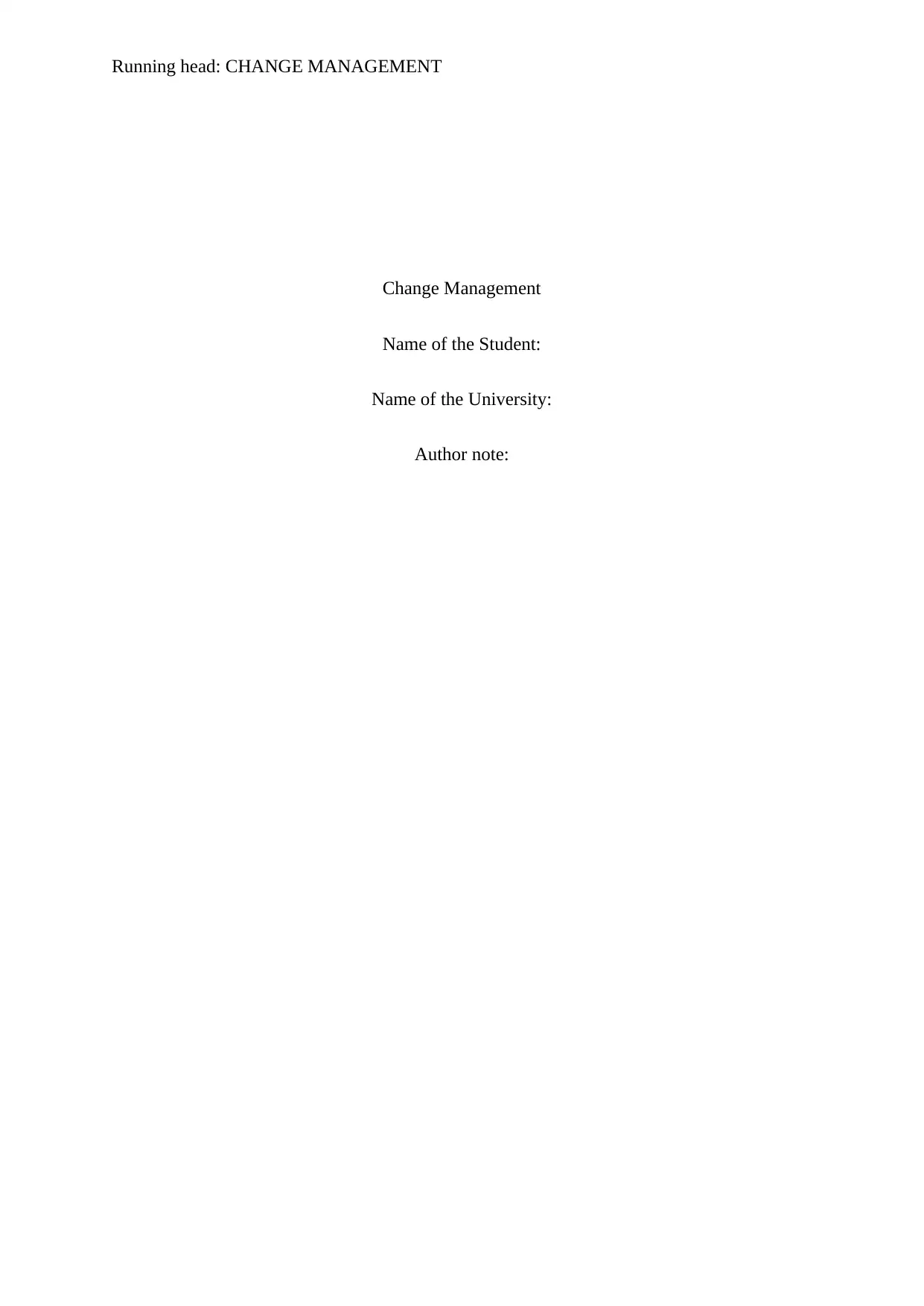
Running head: CHANGE MANAGEMENT
Change Management
Name of the Student:
Name of the University:
Author note:
Change Management
Name of the Student:
Name of the University:
Author note:
Paraphrase This Document
Need a fresh take? Get an instant paraphrase of this document with our AI Paraphraser
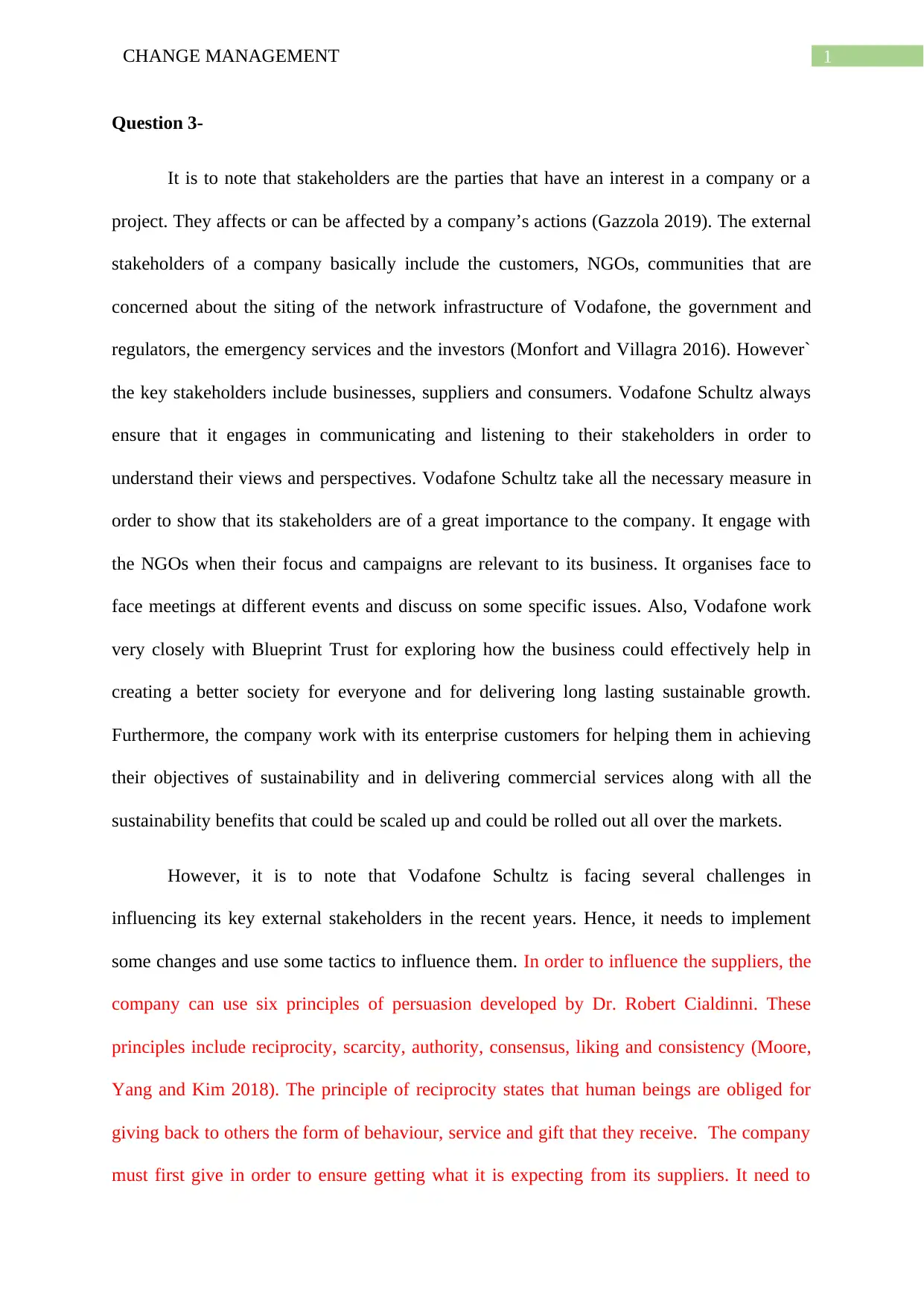
1CHANGE MANAGEMENT
Question 3-
It is to note that stakeholders are the parties that have an interest in a company or a
project. They affects or can be affected by a company’s actions (Gazzola 2019). The external
stakeholders of a company basically include the customers, NGOs, communities that are
concerned about the siting of the network infrastructure of Vodafone, the government and
regulators, the emergency services and the investors (Monfort and Villagra 2016). However`
the key stakeholders include businesses, suppliers and consumers. Vodafone Schultz always
ensure that it engages in communicating and listening to their stakeholders in order to
understand their views and perspectives. Vodafone Schultz take all the necessary measure in
order to show that its stakeholders are of a great importance to the company. It engage with
the NGOs when their focus and campaigns are relevant to its business. It organises face to
face meetings at different events and discuss on some specific issues. Also, Vodafone work
very closely with Blueprint Trust for exploring how the business could effectively help in
creating a better society for everyone and for delivering long lasting sustainable growth.
Furthermore, the company work with its enterprise customers for helping them in achieving
their objectives of sustainability and in delivering commercial services along with all the
sustainability benefits that could be scaled up and could be rolled out all over the markets.
However, it is to note that Vodafone Schultz is facing several challenges in
influencing its key external stakeholders in the recent years. Hence, it needs to implement
some changes and use some tactics to influence them. In order to influence the suppliers, the
company can use six principles of persuasion developed by Dr. Robert Cialdinni. These
principles include reciprocity, scarcity, authority, consensus, liking and consistency (Moore,
Yang and Kim 2018). The principle of reciprocity states that human beings are obliged for
giving back to others the form of behaviour, service and gift that they receive. The company
must first give in order to ensure getting what it is expecting from its suppliers. It need to
Question 3-
It is to note that stakeholders are the parties that have an interest in a company or a
project. They affects or can be affected by a company’s actions (Gazzola 2019). The external
stakeholders of a company basically include the customers, NGOs, communities that are
concerned about the siting of the network infrastructure of Vodafone, the government and
regulators, the emergency services and the investors (Monfort and Villagra 2016). However`
the key stakeholders include businesses, suppliers and consumers. Vodafone Schultz always
ensure that it engages in communicating and listening to their stakeholders in order to
understand their views and perspectives. Vodafone Schultz take all the necessary measure in
order to show that its stakeholders are of a great importance to the company. It engage with
the NGOs when their focus and campaigns are relevant to its business. It organises face to
face meetings at different events and discuss on some specific issues. Also, Vodafone work
very closely with Blueprint Trust for exploring how the business could effectively help in
creating a better society for everyone and for delivering long lasting sustainable growth.
Furthermore, the company work with its enterprise customers for helping them in achieving
their objectives of sustainability and in delivering commercial services along with all the
sustainability benefits that could be scaled up and could be rolled out all over the markets.
However, it is to note that Vodafone Schultz is facing several challenges in
influencing its key external stakeholders in the recent years. Hence, it needs to implement
some changes and use some tactics to influence them. In order to influence the suppliers, the
company can use six principles of persuasion developed by Dr. Robert Cialdinni. These
principles include reciprocity, scarcity, authority, consensus, liking and consistency (Moore,
Yang and Kim 2018). The principle of reciprocity states that human beings are obliged for
giving back to others the form of behaviour, service and gift that they receive. The company
must first give in order to ensure getting what it is expecting from its suppliers. It need to
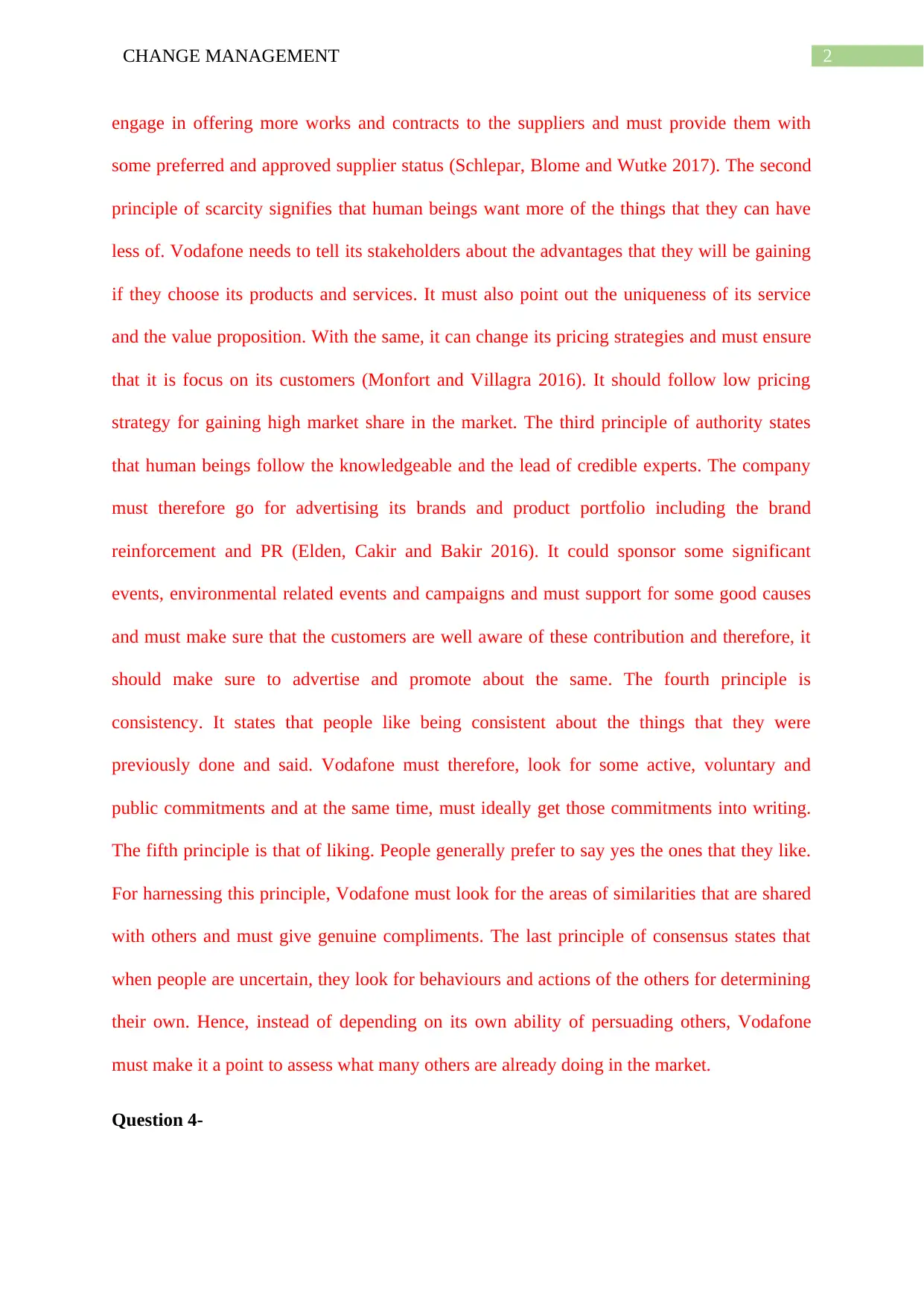
2CHANGE MANAGEMENT
engage in offering more works and contracts to the suppliers and must provide them with
some preferred and approved supplier status (Schlepar, Blome and Wutke 2017). The second
principle of scarcity signifies that human beings want more of the things that they can have
less of. Vodafone needs to tell its stakeholders about the advantages that they will be gaining
if they choose its products and services. It must also point out the uniqueness of its service
and the value proposition. With the same, it can change its pricing strategies and must ensure
that it is focus on its customers (Monfort and Villagra 2016). It should follow low pricing
strategy for gaining high market share in the market. The third principle of authority states
that human beings follow the knowledgeable and the lead of credible experts. The company
must therefore go for advertising its brands and product portfolio including the brand
reinforcement and PR (Elden, Cakir and Bakir 2016). It could sponsor some significant
events, environmental related events and campaigns and must support for some good causes
and must make sure that the customers are well aware of these contribution and therefore, it
should make sure to advertise and promote about the same. The fourth principle is
consistency. It states that people like being consistent about the things that they were
previously done and said. Vodafone must therefore, look for some active, voluntary and
public commitments and at the same time, must ideally get those commitments into writing.
The fifth principle is that of liking. People generally prefer to say yes the ones that they like.
For harnessing this principle, Vodafone must look for the areas of similarities that are shared
with others and must give genuine compliments. The last principle of consensus states that
when people are uncertain, they look for behaviours and actions of the others for determining
their own. Hence, instead of depending on its own ability of persuading others, Vodafone
must make it a point to assess what many others are already doing in the market.
Question 4-
engage in offering more works and contracts to the suppliers and must provide them with
some preferred and approved supplier status (Schlepar, Blome and Wutke 2017). The second
principle of scarcity signifies that human beings want more of the things that they can have
less of. Vodafone needs to tell its stakeholders about the advantages that they will be gaining
if they choose its products and services. It must also point out the uniqueness of its service
and the value proposition. With the same, it can change its pricing strategies and must ensure
that it is focus on its customers (Monfort and Villagra 2016). It should follow low pricing
strategy for gaining high market share in the market. The third principle of authority states
that human beings follow the knowledgeable and the lead of credible experts. The company
must therefore go for advertising its brands and product portfolio including the brand
reinforcement and PR (Elden, Cakir and Bakir 2016). It could sponsor some significant
events, environmental related events and campaigns and must support for some good causes
and must make sure that the customers are well aware of these contribution and therefore, it
should make sure to advertise and promote about the same. The fourth principle is
consistency. It states that people like being consistent about the things that they were
previously done and said. Vodafone must therefore, look for some active, voluntary and
public commitments and at the same time, must ideally get those commitments into writing.
The fifth principle is that of liking. People generally prefer to say yes the ones that they like.
For harnessing this principle, Vodafone must look for the areas of similarities that are shared
with others and must give genuine compliments. The last principle of consensus states that
when people are uncertain, they look for behaviours and actions of the others for determining
their own. Hence, instead of depending on its own ability of persuading others, Vodafone
must make it a point to assess what many others are already doing in the market.
Question 4-
⊘ This is a preview!⊘
Do you want full access?
Subscribe today to unlock all pages.

Trusted by 1+ million students worldwide
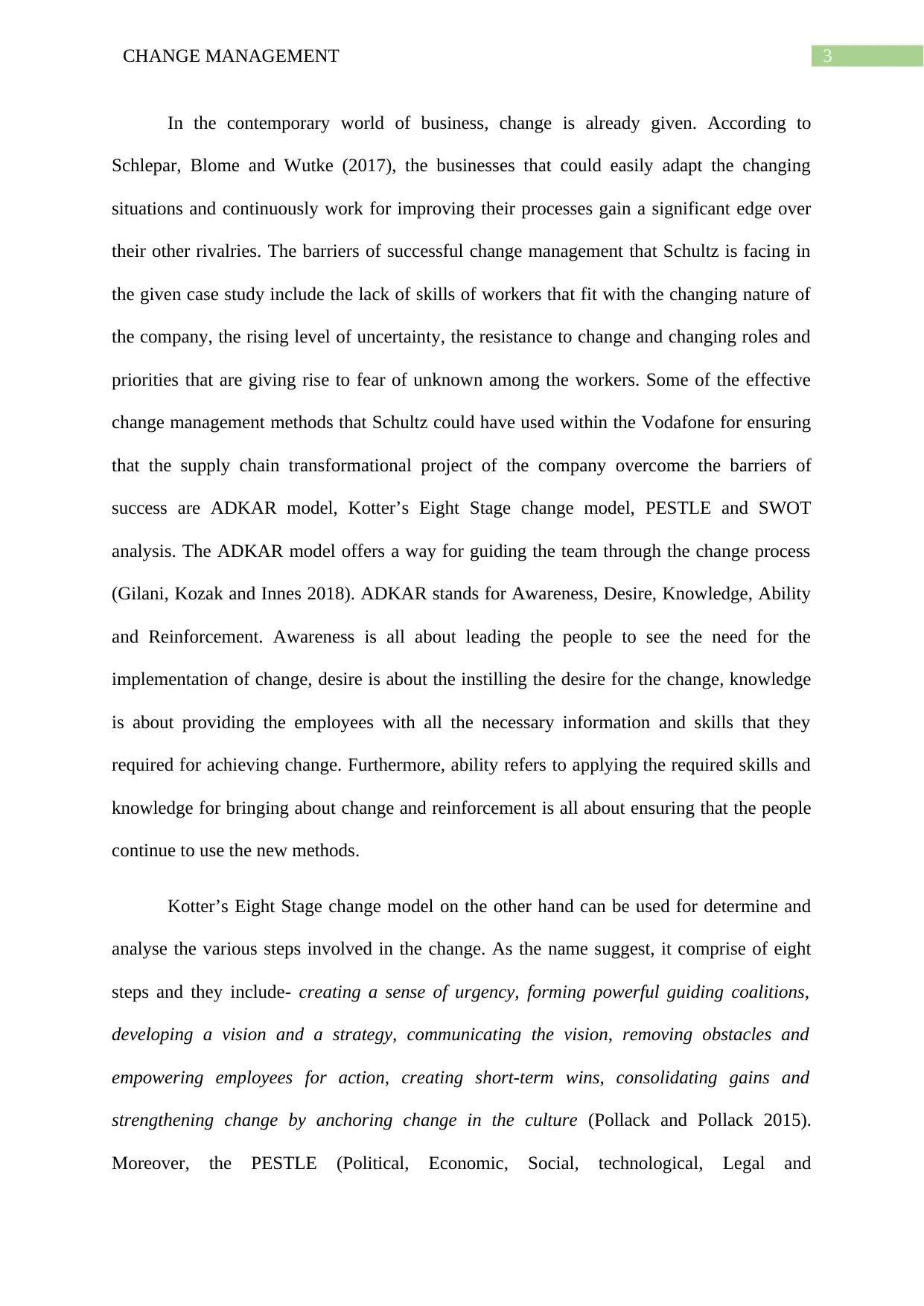
3CHANGE MANAGEMENT
In the contemporary world of business, change is already given. According to
Schlepar, Blome and Wutke (2017), the businesses that could easily adapt the changing
situations and continuously work for improving their processes gain a significant edge over
their other rivalries. The barriers of successful change management that Schultz is facing in
the given case study include the lack of skills of workers that fit with the changing nature of
the company, the rising level of uncertainty, the resistance to change and changing roles and
priorities that are giving rise to fear of unknown among the workers. Some of the effective
change management methods that Schultz could have used within the Vodafone for ensuring
that the supply chain transformational project of the company overcome the barriers of
success are ADKAR model, Kotter’s Eight Stage change model, PESTLE and SWOT
analysis. The ADKAR model offers a way for guiding the team through the change process
(Gilani, Kozak and Innes 2018). ADKAR stands for Awareness, Desire, Knowledge, Ability
and Reinforcement. Awareness is all about leading the people to see the need for the
implementation of change, desire is about the instilling the desire for the change, knowledge
is about providing the employees with all the necessary information and skills that they
required for achieving change. Furthermore, ability refers to applying the required skills and
knowledge for bringing about change and reinforcement is all about ensuring that the people
continue to use the new methods.
Kotter’s Eight Stage change model on the other hand can be used for determine and
analyse the various steps involved in the change. As the name suggest, it comprise of eight
steps and they include- creating a sense of urgency, forming powerful guiding coalitions,
developing a vision and a strategy, communicating the vision, removing obstacles and
empowering employees for action, creating short-term wins, consolidating gains and
strengthening change by anchoring change in the culture (Pollack and Pollack 2015).
Moreover, the PESTLE (Political, Economic, Social, technological, Legal and
In the contemporary world of business, change is already given. According to
Schlepar, Blome and Wutke (2017), the businesses that could easily adapt the changing
situations and continuously work for improving their processes gain a significant edge over
their other rivalries. The barriers of successful change management that Schultz is facing in
the given case study include the lack of skills of workers that fit with the changing nature of
the company, the rising level of uncertainty, the resistance to change and changing roles and
priorities that are giving rise to fear of unknown among the workers. Some of the effective
change management methods that Schultz could have used within the Vodafone for ensuring
that the supply chain transformational project of the company overcome the barriers of
success are ADKAR model, Kotter’s Eight Stage change model, PESTLE and SWOT
analysis. The ADKAR model offers a way for guiding the team through the change process
(Gilani, Kozak and Innes 2018). ADKAR stands for Awareness, Desire, Knowledge, Ability
and Reinforcement. Awareness is all about leading the people to see the need for the
implementation of change, desire is about the instilling the desire for the change, knowledge
is about providing the employees with all the necessary information and skills that they
required for achieving change. Furthermore, ability refers to applying the required skills and
knowledge for bringing about change and reinforcement is all about ensuring that the people
continue to use the new methods.
Kotter’s Eight Stage change model on the other hand can be used for determine and
analyse the various steps involved in the change. As the name suggest, it comprise of eight
steps and they include- creating a sense of urgency, forming powerful guiding coalitions,
developing a vision and a strategy, communicating the vision, removing obstacles and
empowering employees for action, creating short-term wins, consolidating gains and
strengthening change by anchoring change in the culture (Pollack and Pollack 2015).
Moreover, the PESTLE (Political, Economic, Social, technological, Legal and
Paraphrase This Document
Need a fresh take? Get an instant paraphrase of this document with our AI Paraphraser
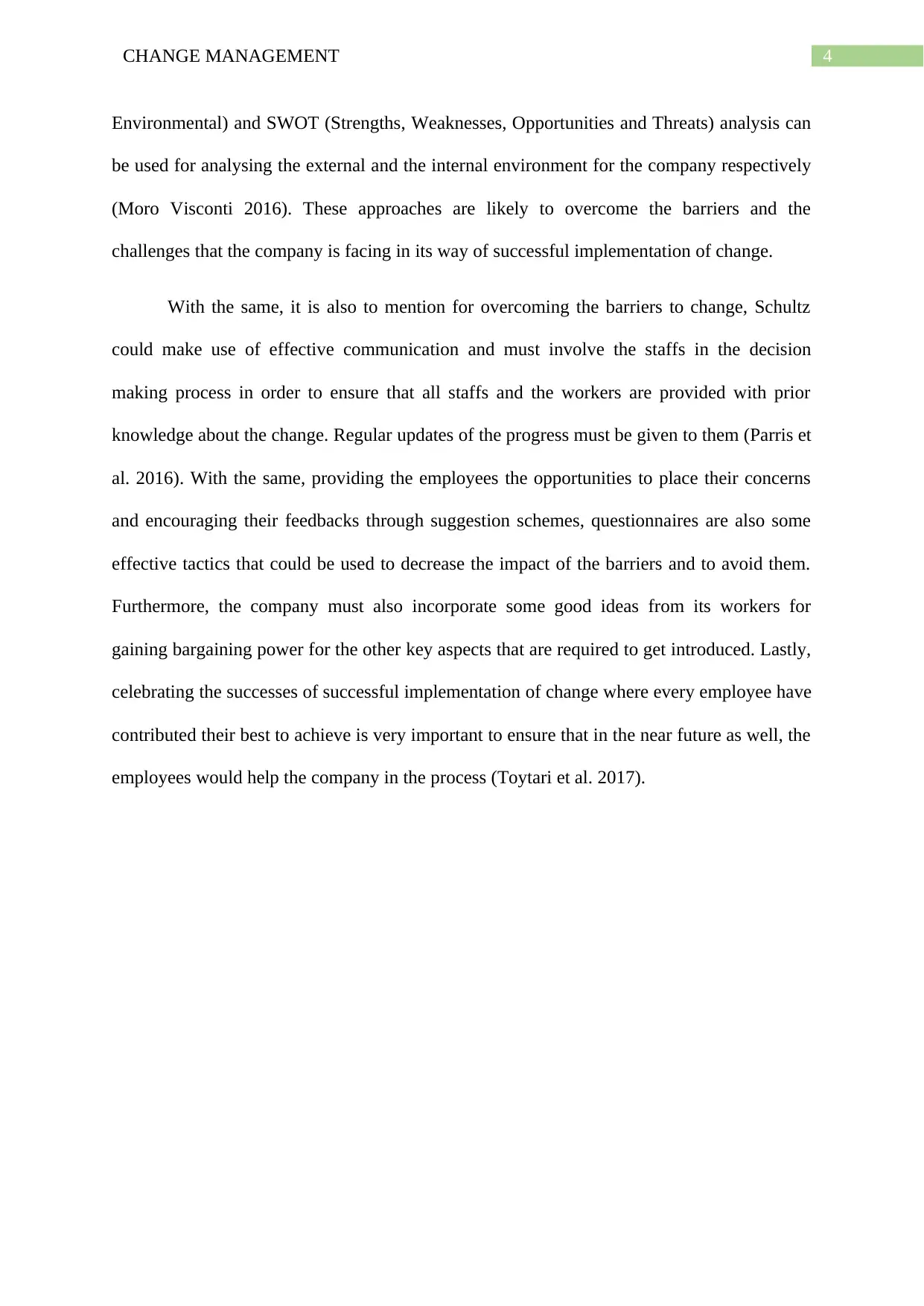
4CHANGE MANAGEMENT
Environmental) and SWOT (Strengths, Weaknesses, Opportunities and Threats) analysis can
be used for analysing the external and the internal environment for the company respectively
(Moro Visconti 2016). These approaches are likely to overcome the barriers and the
challenges that the company is facing in its way of successful implementation of change.
With the same, it is also to mention for overcoming the barriers to change, Schultz
could make use of effective communication and must involve the staffs in the decision
making process in order to ensure that all staffs and the workers are provided with prior
knowledge about the change. Regular updates of the progress must be given to them (Parris et
al. 2016). With the same, providing the employees the opportunities to place their concerns
and encouraging their feedbacks through suggestion schemes, questionnaires are also some
effective tactics that could be used to decrease the impact of the barriers and to avoid them.
Furthermore, the company must also incorporate some good ideas from its workers for
gaining bargaining power for the other key aspects that are required to get introduced. Lastly,
celebrating the successes of successful implementation of change where every employee have
contributed their best to achieve is very important to ensure that in the near future as well, the
employees would help the company in the process (Toytari et al. 2017).
Environmental) and SWOT (Strengths, Weaknesses, Opportunities and Threats) analysis can
be used for analysing the external and the internal environment for the company respectively
(Moro Visconti 2016). These approaches are likely to overcome the barriers and the
challenges that the company is facing in its way of successful implementation of change.
With the same, it is also to mention for overcoming the barriers to change, Schultz
could make use of effective communication and must involve the staffs in the decision
making process in order to ensure that all staffs and the workers are provided with prior
knowledge about the change. Regular updates of the progress must be given to them (Parris et
al. 2016). With the same, providing the employees the opportunities to place their concerns
and encouraging their feedbacks through suggestion schemes, questionnaires are also some
effective tactics that could be used to decrease the impact of the barriers and to avoid them.
Furthermore, the company must also incorporate some good ideas from its workers for
gaining bargaining power for the other key aspects that are required to get introduced. Lastly,
celebrating the successes of successful implementation of change where every employee have
contributed their best to achieve is very important to ensure that in the near future as well, the
employees would help the company in the process (Toytari et al. 2017).
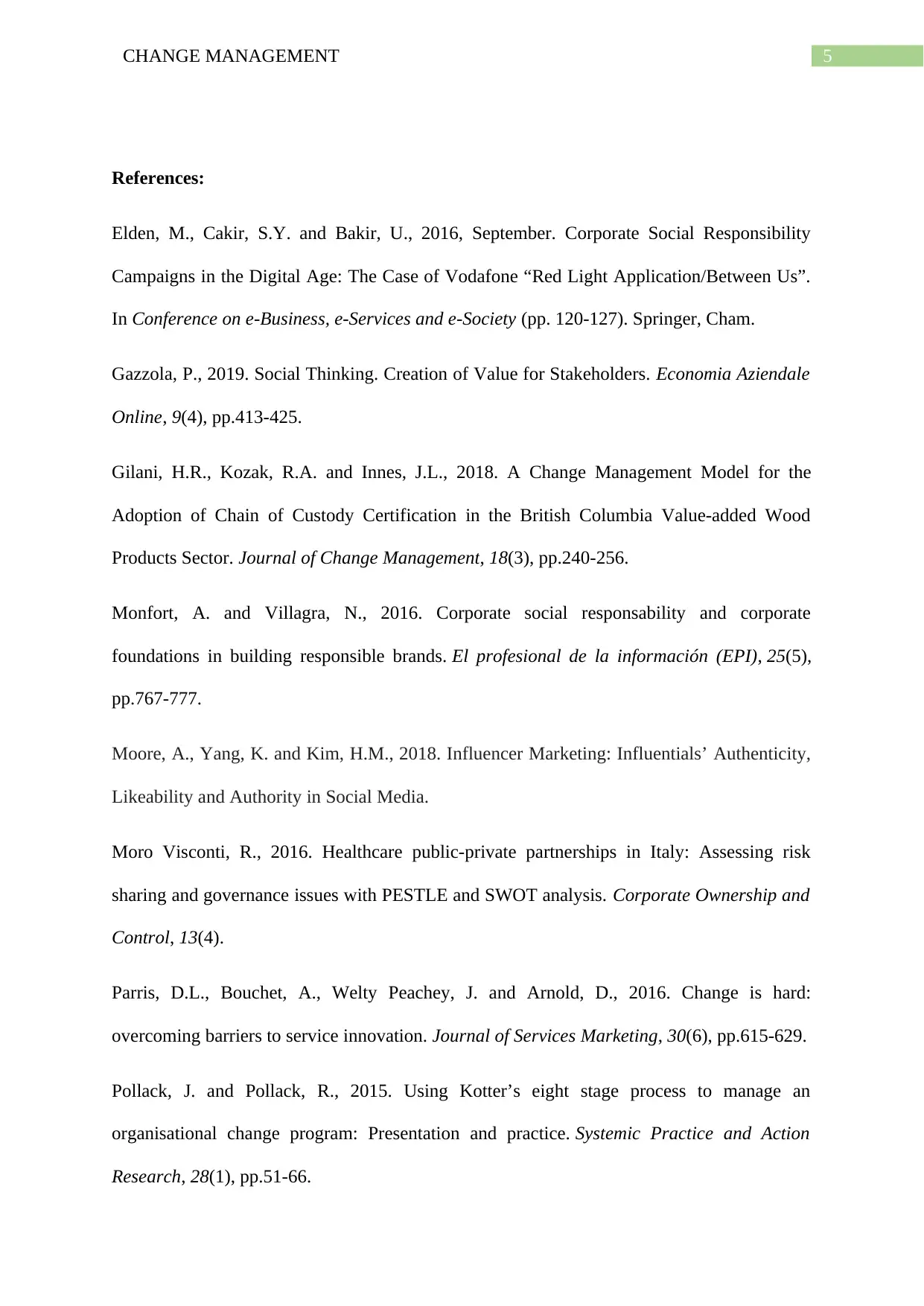
5CHANGE MANAGEMENT
References:
Elden, M., Cakir, S.Y. and Bakir, U., 2016, September. Corporate Social Responsibility
Campaigns in the Digital Age: The Case of Vodafone “Red Light Application/Between Us”.
In Conference on e-Business, e-Services and e-Society (pp. 120-127). Springer, Cham.
Gazzola, P., 2019. Social Thinking. Creation of Value for Stakeholders. Economia Aziendale
Online, 9(4), pp.413-425.
Gilani, H.R., Kozak, R.A. and Innes, J.L., 2018. A Change Management Model for the
Adoption of Chain of Custody Certification in the British Columbia Value-added Wood
Products Sector. Journal of Change Management, 18(3), pp.240-256.
Monfort, A. and Villagra, N., 2016. Corporate social responsability and corporate
foundations in building responsible brands. El profesional de la información (EPI), 25(5),
pp.767-777.
Moore, A., Yang, K. and Kim, H.M., 2018. Influencer Marketing: Influentials’ Authenticity,
Likeability and Authority in Social Media.
Moro Visconti, R., 2016. Healthcare public-private partnerships in Italy: Assessing risk
sharing and governance issues with PESTLE and SWOT analysis. Corporate Ownership and
Control, 13(4).
Parris, D.L., Bouchet, A., Welty Peachey, J. and Arnold, D., 2016. Change is hard:
overcoming barriers to service innovation. Journal of Services Marketing, 30(6), pp.615-629.
Pollack, J. and Pollack, R., 2015. Using Kotter’s eight stage process to manage an
organisational change program: Presentation and practice. Systemic Practice and Action
Research, 28(1), pp.51-66.
References:
Elden, M., Cakir, S.Y. and Bakir, U., 2016, September. Corporate Social Responsibility
Campaigns in the Digital Age: The Case of Vodafone “Red Light Application/Between Us”.
In Conference on e-Business, e-Services and e-Society (pp. 120-127). Springer, Cham.
Gazzola, P., 2019. Social Thinking. Creation of Value for Stakeholders. Economia Aziendale
Online, 9(4), pp.413-425.
Gilani, H.R., Kozak, R.A. and Innes, J.L., 2018. A Change Management Model for the
Adoption of Chain of Custody Certification in the British Columbia Value-added Wood
Products Sector. Journal of Change Management, 18(3), pp.240-256.
Monfort, A. and Villagra, N., 2016. Corporate social responsability and corporate
foundations in building responsible brands. El profesional de la información (EPI), 25(5),
pp.767-777.
Moore, A., Yang, K. and Kim, H.M., 2018. Influencer Marketing: Influentials’ Authenticity,
Likeability and Authority in Social Media.
Moro Visconti, R., 2016. Healthcare public-private partnerships in Italy: Assessing risk
sharing and governance issues with PESTLE and SWOT analysis. Corporate Ownership and
Control, 13(4).
Parris, D.L., Bouchet, A., Welty Peachey, J. and Arnold, D., 2016. Change is hard:
overcoming barriers to service innovation. Journal of Services Marketing, 30(6), pp.615-629.
Pollack, J. and Pollack, R., 2015. Using Kotter’s eight stage process to manage an
organisational change program: Presentation and practice. Systemic Practice and Action
Research, 28(1), pp.51-66.
⊘ This is a preview!⊘
Do you want full access?
Subscribe today to unlock all pages.

Trusted by 1+ million students worldwide
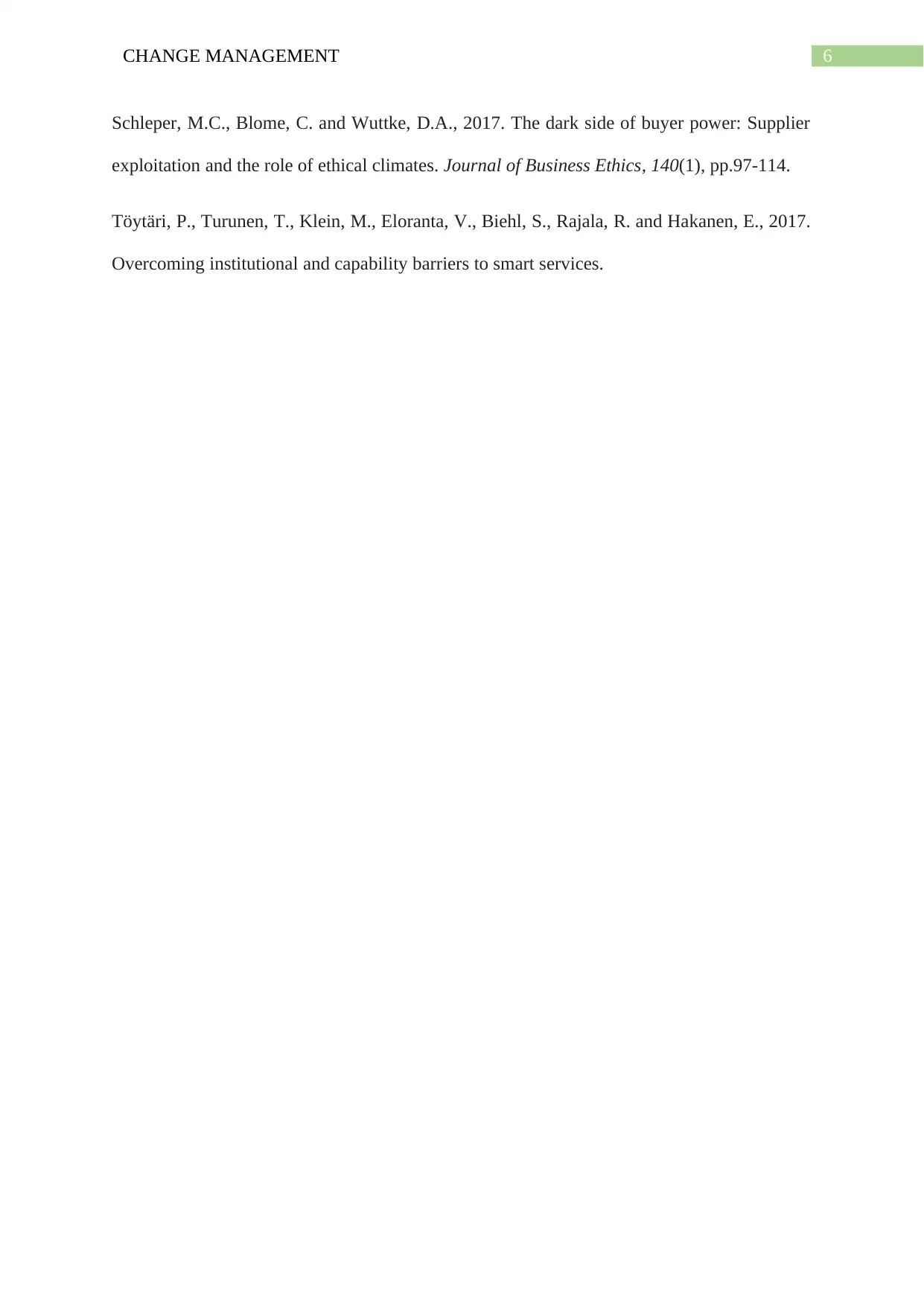
6CHANGE MANAGEMENT
Schleper, M.C., Blome, C. and Wuttke, D.A., 2017. The dark side of buyer power: Supplier
exploitation and the role of ethical climates. Journal of Business Ethics, 140(1), pp.97-114.
Töytäri, P., Turunen, T., Klein, M., Eloranta, V., Biehl, S., Rajala, R. and Hakanen, E., 2017.
Overcoming institutional and capability barriers to smart services.
Schleper, M.C., Blome, C. and Wuttke, D.A., 2017. The dark side of buyer power: Supplier
exploitation and the role of ethical climates. Journal of Business Ethics, 140(1), pp.97-114.
Töytäri, P., Turunen, T., Klein, M., Eloranta, V., Biehl, S., Rajala, R. and Hakanen, E., 2017.
Overcoming institutional and capability barriers to smart services.
1 out of 7
Related Documents
Your All-in-One AI-Powered Toolkit for Academic Success.
+13062052269
info@desklib.com
Available 24*7 on WhatsApp / Email
![[object Object]](/_next/static/media/star-bottom.7253800d.svg)
Unlock your academic potential
Copyright © 2020–2025 A2Z Services. All Rights Reserved. Developed and managed by ZUCOL.





